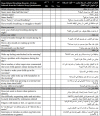Risk of Obstructive Sleep Apnea in Saudi Male Boys with Duchenne Muscular Dystrophy (DMD)
- PMID: 37601287
- PMCID: PMC10439780
- DOI: 10.2147/DNND.S421399
Risk of Obstructive Sleep Apnea in Saudi Male Boys with Duchenne Muscular Dystrophy (DMD)
Abstract
Background: Duchenne muscular dystrophy (DMD) patients are at a high risk of developing sleep-related breathing disorders (SRBD) such as obstructive sleep apnea (OSA). This study aimed to determine the risk of developing OSA among DMD patients.
Methods: This cross-sectional study was conducted from February 2022 to July 2022 in a tertiary healthcare facility. As a screening tool for OSA, we used the Pediatric Sleep Questionnaire (PSQ).
Results: Subjects included 60 boys with DMD, mean age 10.15 ± 3.54 years. The mean BMI for all subjects was 18.9 ± 4.08 kg/m2. Of these, 22 (36.7%) children were at high risk of OSA. Children who were overweight, and on steroids tended to be at higher risk of developing OSA (P < 0.043) and (P < 0.029) respectively.
Conclusion: Our study shows a significant risk of OSA in DMD patients. Therefore, Sleep studies should be part of the standard of care for DMD patients.
Keywords: Duchenne muscular dystrophy; Saudi Arabia; obstructive sleep apnea; pediatric sleep questionnaire.
© 2023 Bamaga and Alqarni.
Conflict of interest statement
The authors have no conflict of interest to report.
Figures
Similar articles
-
Sleep-Disordered Breathing in Duchenne Muscular Dystrophy: An Assessment of the Literature.J Clin Sleep Med. 2016 Jun 15;12(6):905-11. doi: 10.5664/jcsm.5898. J Clin Sleep Med. 2016. PMID: 27070248 Free PMC article. Review.
-
Characterization of sleep-disordered breathing in children with Duchenne muscular dystrophy by the American Academy of Sleep Medicine criteria vs disease-specific criteria: what are the differences?J Clin Sleep Med. 2022 Feb 1;18(2):609-616. doi: 10.5664/jcsm.9678. J Clin Sleep Med. 2022. PMID: 34583806 Free PMC article.
-
The Relationship between Obesity and Clinical Outcomes in Young People with Duchenne Muscular Dystrophy.Nutrients. 2022 Aug 12;14(16):3304. doi: 10.3390/nu14163304. Nutrients. 2022. PMID: 36014811 Free PMC article.
-
Sleep disordered breathing in young boys with Duchenne muscular dystrophy.J Pediatr. 2015 Mar;166(3):640-5.e1. doi: 10.1016/j.jpeds.2014.12.006. J Pediatr. 2015. PMID: 25722267
-
Lifetime Care of Duchenne Muscular Dystrophy.Sleep Med Clin. 2020 Dec;15(4):485-495. doi: 10.1016/j.jsmc.2020.08.011. Epub 2020 Oct 5. Sleep Med Clin. 2020. PMID: 33131659 Free PMC article. Review.
Cited by
-
Respiratory performance in Duchenne muscular dystrophy: Clinical manifestations and lessons from animal models.Exp Physiol. 2024 Sep;109(9):1426-1445. doi: 10.1113/EP091967. Epub 2024 Jul 18. Exp Physiol. 2024. PMID: 39023735 Free PMC article. Review.
References
LinkOut - more resources
Full Text Sources
Research Materials




